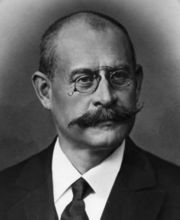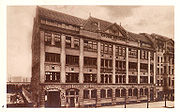
Knorr-Bremse
Encyclopedia



Brake
A brake is a mechanical device which inhibits motion. Its opposite component is a clutch. The rest of this article is dedicated to various types of vehicular brakes....
systems for rail
Railroad car
A railroad car or railway vehicle , also known as a bogie in Indian English, is a vehicle on a rail transport system that is used for the carrying of cargo or passengers. Cars can be coupled together into a train and hauled by one or more locomotives...
and commercial vehicles
Truck
A truck or lorry is a motor vehicle designed to transport cargo. Trucks vary greatly in size, power, and configuration, with the smallest being mechanically similar to an automobile...
that has operated in the field for over 100 years. The company also produces door systems for rail vehicles and torsional dampers. In 2009, the Group's workforce of over 14,000 achieved worldwide sales of EUR 2.761 billion.
History
Inventor Georg KnorrGeorg Knorr
Theodor Georg Knorr , was an engineer and entrepreneur on the field of railroad technology and founder of the company Knorr-Bremse...
founded Knorr-Bremse in 1905 in Berlin. The initial basis for the company's commercial success was provided by an agreement with the Prussian State Railways to supply single-chamber express braking systems
Air brake (rail)
An air brake is a conveyance braking system actuated by compressed air. Modern trains rely upon a fail-safe air brake system that is based upon a design patented by George Westinghouse on March 5, 1872. The Westinghouse Air Brake Company was subsequently organized to manufacture and sell...
offering considerably enhanced safety performance compared with traditional systems. In the early twentieth century, train guards still had to operate the brakes by hand, from so-called "brake vans". The first pneumatic brakes
Air brake (rail)
An air brake is a conveyance braking system actuated by compressed air. Modern trains rely upon a fail-safe air brake system that is based upon a design patented by George Westinghouse on March 5, 1872. The Westinghouse Air Brake Company was subsequently organized to manufacture and sell...
were of a basic design, but before long, indirect automatic systems using a control valve were developed.
See History of rail transport in Germany
History of rail transport in Germany
German Railway history began with the opening of the steam-hauled Bavarian Ludwig Railway between Nuremberg and Fürth on 7 December 1835. This had been preceded by the opening of the horse-hauled Prince William Railway on 20 September 1831...
.
The second main area of activity for Knorr-Bremse emerged in 1922, when they moved into pneumatic braking
Air brake (road vehicle)
Air brakes are used in trucks, buses, trailers, and semi-trailers. George Westinghouse first developed air brakes for use in railway service. He patented a safer air brake on March 5, 1872. Originally designed and built for use on railroad train application, air brakes remain the exclusive systems...
systems for commercial road vehicles. Knorr-Bremse was the first European company to develop a new pneumatic system that applied the brakes simultaneously to all four wheels of a truck as well as its trailer. The resultant reduction in braking distances made a significant contribution to improving road safety.
A less talked about part of the company's history was the manufacture of the MG35/36 machine gun, known as the "Knorr-Bremse", for the Waffen-SS
Waffen-SS
The Waffen-SS was a multi-ethnic and multi-national military force of the Third Reich. It constituted the armed wing of the Schutzstaffel or SS, an organ of the Nazi Party. The Waffen-SS saw action throughout World War II and grew from three regiments to over 38 divisions, and served alongside...
and the Wehrmacht
Wehrmacht
The Wehrmacht – from , to defend and , the might/power) were the unified armed forces of Nazi Germany from 1935 to 1945. It consisted of the Heer , the Kriegsmarine and the Luftwaffe .-Origin and use of the term:...
.
Knorr Bremse then bought Bendix Commercial Vehicle Systems from Honeywell to make it the leading company in the brake system industry.
| 1905 | Georg Knorr founds Knorr-Bremse GmbH in Berlin. |
| 1910–24 | Knorr-Bremse develops air brakes for freight trains and becomes a major European manufacturer of rail vehicle brakes. |
| 1922 | Development of air brakes for commercial vehicles commences. |
| 1931–39 | The Hildebrand-Knorr (HiK) braking system used for express trains in 17 countries. 90% of all German trucks in the 7–16 t range are fitted with Knorr braking systems. |
| 1945–53 | Development and manufacture of braking systems begins again in the western part of Germany, with the main emphasis on the HiK system. Company headquarters are relocated to Munich. |
| 1985–93 | During a difficult phase in the company's development, Heinz Hermann Thiele acquires a majority share in Knorr-Bremse and launches a radical restructuring program and becomes a global player. The AAR DB60 control valve gains Knorr-Bremse access to the North American market. |
| 1996 | Series production of pneumatic disc brakes for commercial vehicles begins. |
| 1999 | Robert Bosch GmbH merges its activities in the electronic brake control sector with Knorr-Bremse Commercial Vehicle Systems. Knorr-Bremse takes a 60% share, giving it overall managerial control of the joint venture; Bosch retains a 20% share. |
| 2002 | Knorr-Bremse takes over from Honeywell International Inc., USA its share of joint ventures in Europe, Brazil and the USA. Bendix Commercial Vehicle Systems becomes a subsidiary of Knorr-Bremse AG. The Knorr-Bremse Group achieves sales of EUR 2.1 billion for the first time. |
| 2005 | Centenary of operation. |
Rail vehicles
Knorr-Bremse not only produces complete braking systems for all types of rolling stock but also door systems, toiletToilet
A toilet is a sanitation fixture used primarily for the disposal of human excrement, often found in a small room referred to as a toilet/bathroom/lavatory...
s, air conditioning
Air conditioning
An air conditioner is a home appliance, system, or mechanism designed to dehumidify and extract heat from an area. The cooling is done using a simple refrigeration cycle...
, couplings
Coupling (railway)
A coupling is a mechanism for connecting rolling stock in a train. The design of the coupler is standard, and is almost as important as the railway gauge, since flexibility and convenience are maximised if all rolling stock can be coupled together.The equipment that connects the couplings to the...
and windscreen wiper
Windscreen wiper
A windscreen wiper or windshield wiper is a device used to remove rain and debris from a windscreen or windshield. Almost all motor vehicles, including trains, aircraft and watercraft, are equipped with such wipers, which are usually a legal requirement.A wiper generally consists of an arm,...
s. In 2000, it purchased British manufacturer, Westinghouse Brakes (formerly the brakes division of Westinghouse Brake and Signal Company Ltd
Westinghouse Brake and Signal Company Ltd
The Westinghouse Brake & Signal Company Ltd was created in 1935 when the Westinghouse Brake & Saxby Signal Company Ltd, dropped the 'Saxby' from their title...
), from Invensys
Invensys
Invensys plc is a global engineering and information technology company headquartered in London, United Kingdom. It was formed in 1999 through the merger of BTR plc and Siebe plc. It has offices in more than 50 countries and its products are sold in around 180 countries.Invensys is organised into...
, and subsequently moved its operations from Chippenham to the nearby English town of Melksham
Melksham
Melksham is a medium-sized English town, lying on the River Avon. It lies in the county of Wiltshire.It is situated southeast of the city of Bath, south of Chippenham, west of Devizes and north of Warminster on the A350 national route. The 2001 UK census cited Melksham as having 20,000...
.
Since 2002, Knorr-Bremse has been working on variable gauge systems for more efficient solutions to break of gauge problems.
Commercial vehicles
Knorr-Bremse has been developing and manufacturing braking systemsAir brake (road vehicle)
Air brakes are used in trucks, buses, trailers, and semi-trailers. George Westinghouse first developed air brakes for use in railway service. He patented a safer air brake on March 5, 1872. Originally designed and built for use on railroad train application, air brakes remain the exclusive systems...
for commercial vehicles since 1920. For truck
Truck
A truck or lorry is a motor vehicle designed to transport cargo. Trucks vary greatly in size, power, and configuration, with the smallest being mechanically similar to an automobile...
s and semi-trailer tractor units
Semi-trailer truck
A semi-trailer truck, also known as a semi, tractor-trailer, or articulated truck or articulated lorry, is an articulated vehicle consisting of a towing engine , and a semi-trailer A semi-trailer truck, also known as a semi, tractor-trailer, or (in the United Kingdom and Ireland) articulated truck...
over 6 tonnes, bus
Bus
A bus is a road vehicle designed to carry passengers. Buses can have a capacity as high as 300 passengers. The most common type of bus is the single-decker bus, with larger loads carried by double-decker buses and articulated buses, and smaller loads carried by midibuses and minibuses; coaches are...
es, trailers
Trailer (vehicle)
A trailer is generally an unpowered vehicle pulled by a powered vehicle. Commonly, the term trailer refers to such vehicles used for transport of goods and materials....
or special vehicles.

